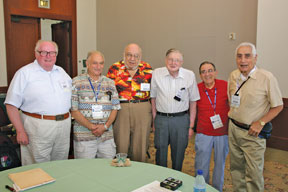 |
| James McNaul is shown at far left
with EMC Founders (from left) Vince Mancino, Milton Kant,
Ralph Showers, Sam Burruano and Tony Zimbalatti during the
2007 IEEE International Symposium on EMC in Honolulu, Hawaii. |
One of the most interesting aspects of my work,
and it isn’t directly EMC, but it certainly is related to
it, was the preparation for the CCIR Plenary Session in January
and February of 1963, where we were worried about getting the
proper frequencies assigned for communications satellites. At
that point in time, they had not really been launched in any operational
system. I was with the Army Communication Satellite Agency and
had the responsibility of being the delegate to all of the NATO
meetings where we were trying to get the positions of all the
NATO countries lined up for a common set of frequencies and common
set of specifications for the use of those frequencies. We had
many, many bilateral NATO meetings. There was a great deal of
uncertainty about the interference potential of the antennas required
at the time. There was the assumption that many of these would
be built around the world, many near urban areas.
Everyone thought everything was clear and most questions had been
answered by September or October of 1962, just a few months before
the plenary. Then the British came up with an objection to the
placements standards for the large dishes. If you remember, in
those days we were pretty much talking about sixty foot dishes,
two to four KW of transmitter power and very low-noise front ends
because you had to get a lot of power up there to get to the satellite,
which couldn’t have a very sophisticated receiver. But,
you had to have a sophisticated receiver on the ground to receive
the low power signals coming from the satellite because there
wasn’t a lot of power to transmit. So, the placement of
the sixty foot dishes was critical. There was still debate about
whether you'd have (1) a stationary satellite or (2) a polar satellite
or (3) many satellites at low altitudes that you'd have to be
tracking from horizon to horizon.
There were a lot of placement issues. The British came up with
the idea that Rayleigh scattering was going to be a very severe
problem. (Rayleigh scattering is when you transmit into a rain
or a mist and you get a general scattering of the radiated energy.)
So they called us, because we had one of the few set-ups where
we could test some of the problems, and asked me what I knew about
Rayleigh scattering.
I said, “Well I know what it is, but that is the extent
of my knowledge.”
They said, “Well, you’ve got two weeks to put together
a position paper so we can submit it to the U.S. Delegation and
then to the next NATO meeting.”
So, I started calling people in various government laboratories
to find out what they had been doing and I found two very strong
interest areas. One was at Hanscom Field in the Boston Area and
the other was at the Stanford Research Institute in California
(where they had been running tests under an Army contract.) So,
I made some very quick visits to these two locations, all in one
three-day coast-to-coast trip. I talked to the various people,
collected their documentation, and came back and worked together
with some of our people and put together a position paper which
I submitted to our U.S. delegation.
The U.S. delegation accepted it and presented it at the next NATO
meeting. I guess it was quite successful because the NATO meeting
voted to agree with it and that became the NATO position at the
plenary convention.
It should be noted that these kinds of late things came up because
people were still trying to figure out all of the implications
and the peculiarities of satellite communications systems. EMC
